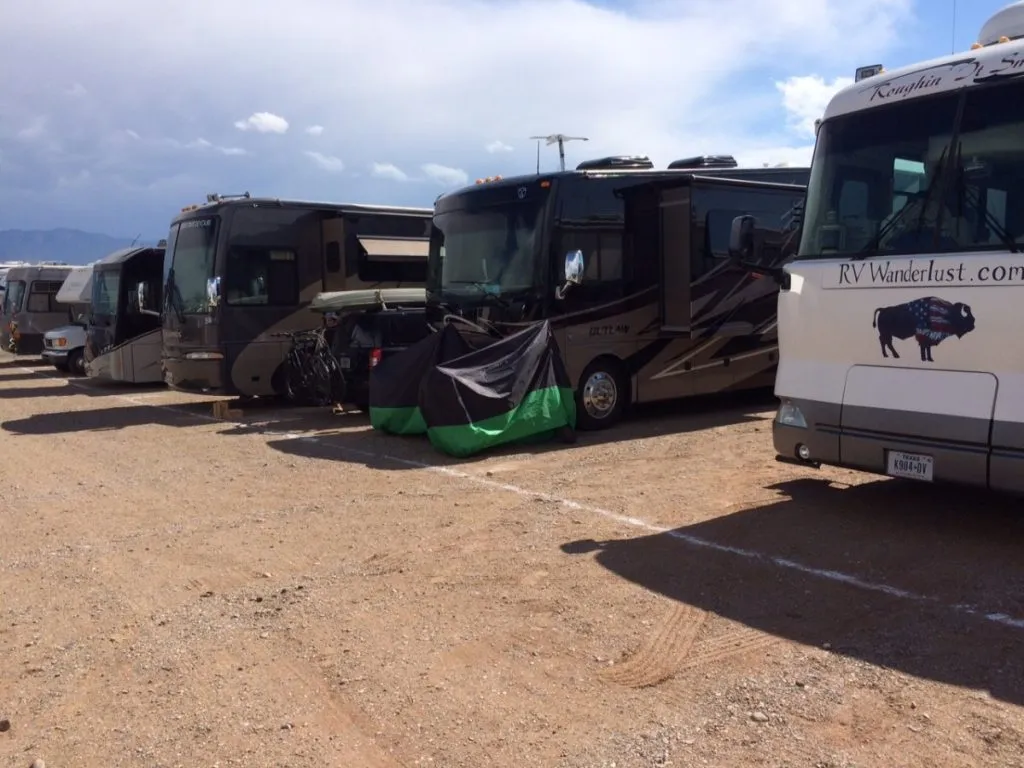
I guess we put the spoiler in the article title…sorry about that. Before I get into the dramatic story of our first full week of RV dry camping, I should make a few things clear:
- If you dry camp regularly, this article will make you laugh at us. So please stop reading now.
- Eric and I are not mechanically-inclined.
- We like our creature comforts. When we’re comfortable, we’re more productive during the work week and have fewer distractions. That’s what we tell ourselves. In our minds, comfort has always been inextricably linked to full hookups. Anything else is just complicated.
- I wish someone had written this article a year and a half ago when we were going on the road. My FOMO has kicked in–how many beautiful places have I missed because I didn’t know I could survive dry camping?
Whew, enough confessions.
Before this month, Eric and I had only ever “dry camped” overnight. Not even 24 hours, people. We knew that didn’t count, just as much as you do.
When we heard that Xscapers was organizing their first-ever convergence at the Albuquerque Balloon Fiesta, and that a ton of our friends were going to be there, we adjusted our travel plans to join the fun. Heck, we even signed up for Xscapers so we could camp alongside everyone else.
As I was making our reservation online, Eric dropped a bombshell: “You know it’s dry camping…right?”
After a moment of silence, I mustered my courage and said, “So?”
After some conversation, we figured that if we were ever going to dry camp for more than one night, where better to do it than surrounded by experienced friends? If we screamed in panic, there would be somewhere there to hear us.
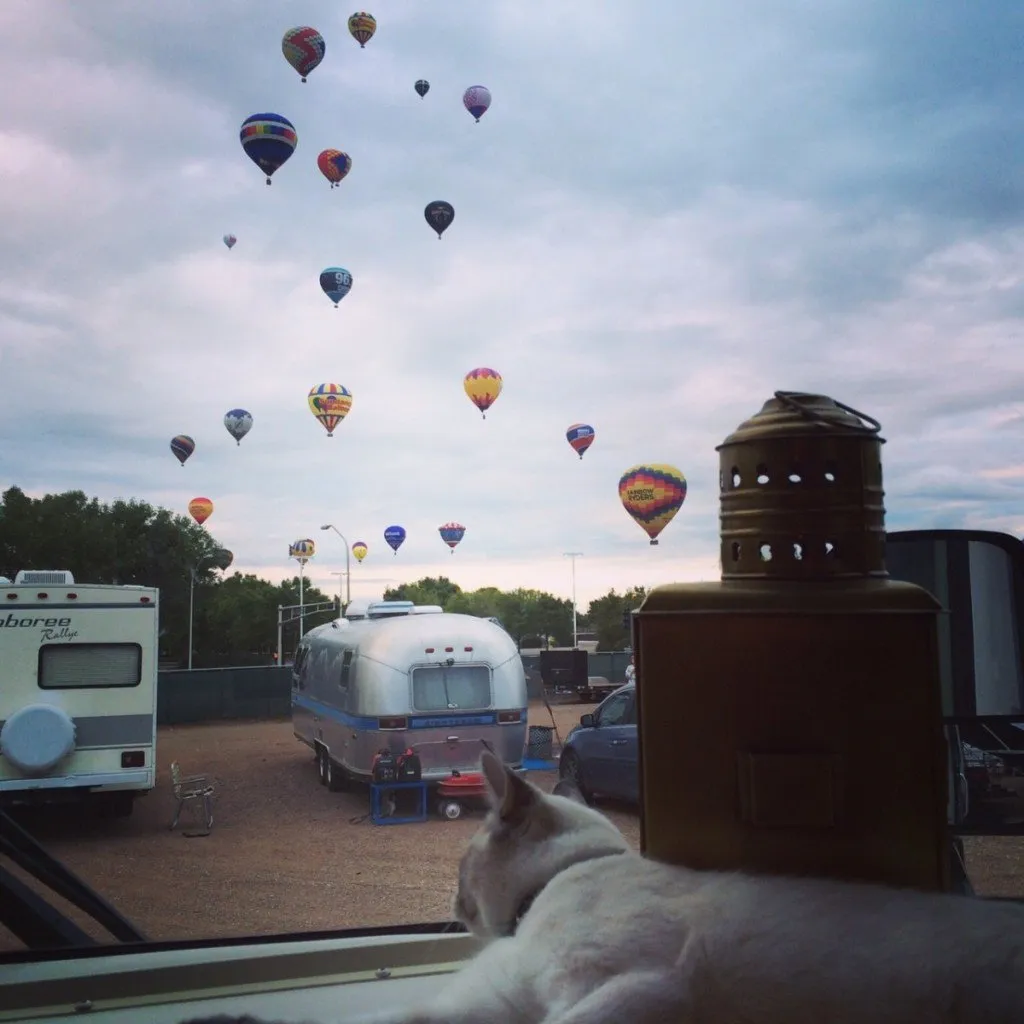
What’s Dry Camping?
Dry camping, also referred to as boondocking, is camping in your RV without hookups. No electricity, water or sewer connections.
Why Would Anyone Dry Camp?
For a long time, Eric and I didn’t think dry camping was “worth it.” But experience on the road, conversation with friends and amazing photos we’ve seen on social media have made us think twice. Here are the main reasons people choose to dry camp:
- Proximity to natural beauty and outdoor wonders you wouldn’t see otherwise.
- Cost savings. Many dry camping locations are completely free.
- Social opportunities. Many RVers gather at events and locations like the Albuquerque Balloon Fiesta or Quartzsite in Arizona. If you want to meet up with friends in similar places, you’ll have to leave the hookups behind.
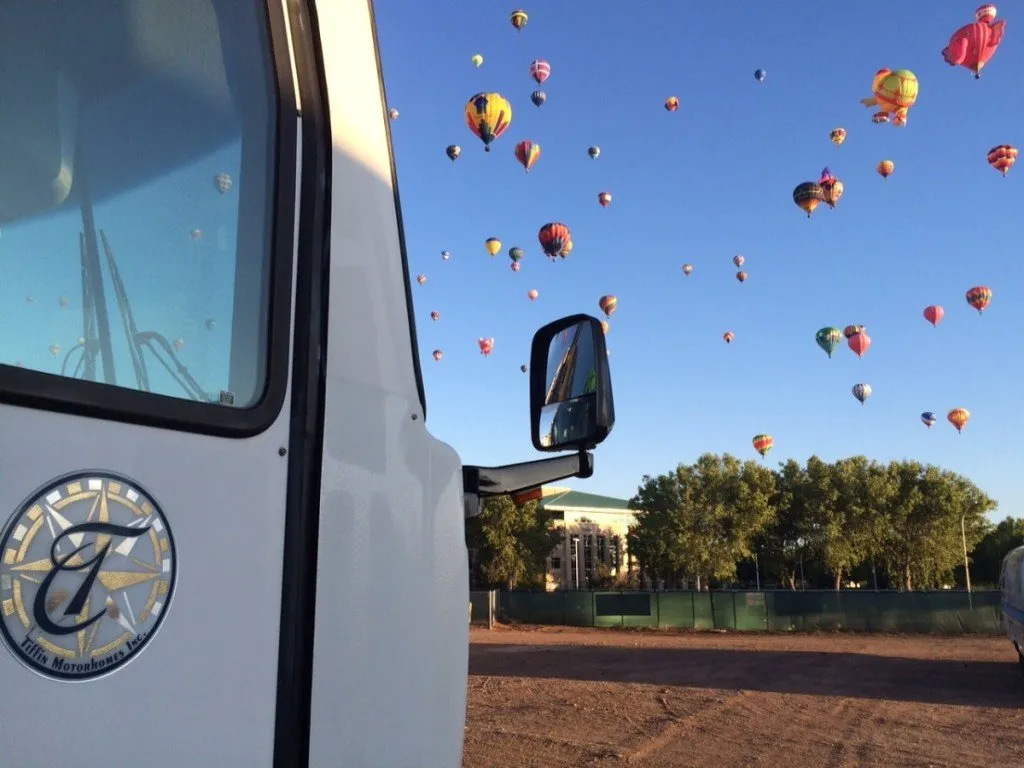
Our First Full Week of Dry Camping: Preparation
The preparations we made for a week without hookups were pretty intuitive:
- Fill up with diesel–the fuel for our generator.
- Fill up with propane–the fuel for our stove and fridge (when we’re not connected to electricity). Propane is also an alternate fuel source for our hot water heater.
- Fill up with fresh water.
- Empty gray and black water tanks.
Depending on your dry camping location, you may also need to grocery shop and get other supplies before leaving civilization.
Know Your Limits
Before you commit to a long stretch of dry camping, you should know your tank capacity and have a rough idea of how long you can last on that capacity. This is one of the best pieces of advice I can give because every RV and RVer is different.
As a 40-foot diesel, we have generous tank sizes:
- 100 gal. diesel
- 30 gal. propane
- 90 gal. fresh water
- 70 gal. gray water
- 45 gal. black water
To find out how long we could last on our tank capacities, we did a few experiments. We went without a sewer connection and found out that we could go almost two weeks without dumping, with regular use. We went without a water connection and found out that we could go a week with one load of laundry, limited showers and normal dish washing. At that level of water use, we were totally fine for fresh water and gray water capacity.
You can refine your experiments as much as you want to. I’d encourage you to, if dry camping is something you’re seriously interested in. If you’re gun-shy like us, do it at a campground where you have full hookups. That way, if you run out of fresh water or fill a tank to the max, the solution is as simple as hooking up. Once you perform your experiments and record the results, you’ll be confident about how long you can dry camp within your comfort zone.
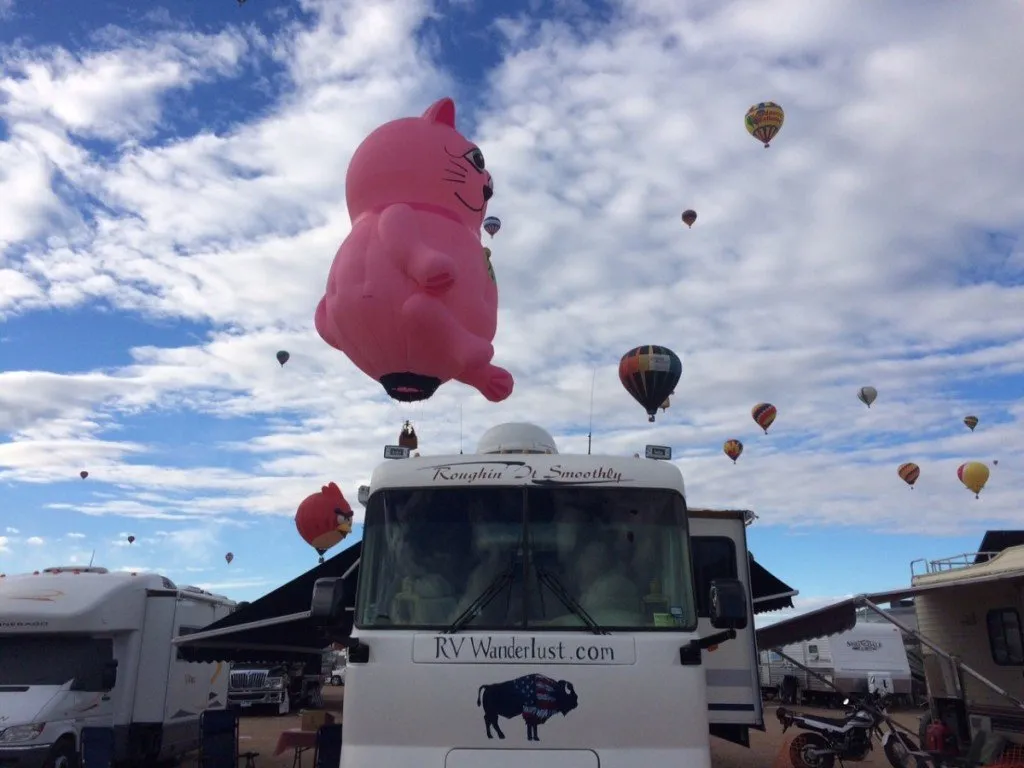
Our First Full Week of Dry Camping: Daily Routine
Equipped with a working understanding of how much capacity our RV has, and what that means for our water and power usage, we settled into a daily routine during our week of dry camping.
Power
We were conscious of how much diesel we were using because there’s a real cost associated with it. To avoid waste, we wanted to run our generator as little as possible. Plus, I hate the noise and fumes!
- We turned on the generator when we got up in the morning and ran it for two hours (6:30-8:30 AM). This was usually enough to recharge our batteries.
- We turned on our inverter to pull power from our four coach batteries for the rest of the morning as we worked.
- More often than not, we ran our generator for two hours in the afternoon to recharge our batteries. Then we went back to battery power.
- We ran our generator for two hours before bed (8-10 PM).
Don’t forget to keep quiet hours in mind. They change from location to location (ours were 10 PM-5 AM). Even when no quiet hours are posted, it’s common courtesy to keep your generator off during sleeping hours if you have anyone near you.
One last note where power is concerned. I turned on the electric water heater when the generator was running if we were going to take shower. I kept it on for anywhere from 20-60 minutes, with 20 minutes being too little and 60 minutes being more than was needed! I didn’t worry about heating water for dishes.
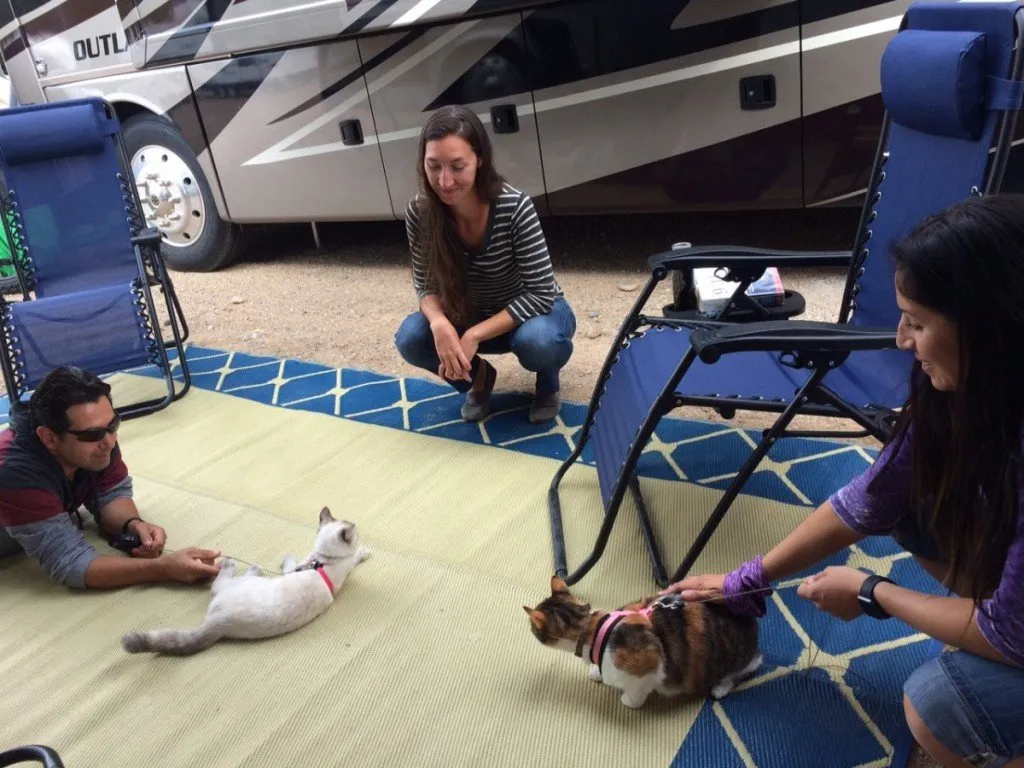
(with our sweet friends Denny and Veronica of RV Outlawz)
Water
We didn’t have any issues with water during our week of dry camping. These were some of the changes to what we’d do normally with full hookups:
- I didn’t run the washer or dryer.
- I was careful when washing dishes and used as little water as possible.
- We took “sailor showers,” basically using water to get wet and rinse.
- I was generally conscious of water usage when washing my hands or doing chores. I avoided activities that would require a lot of water.
Our First Full Week of Dry Camping: Usage Results
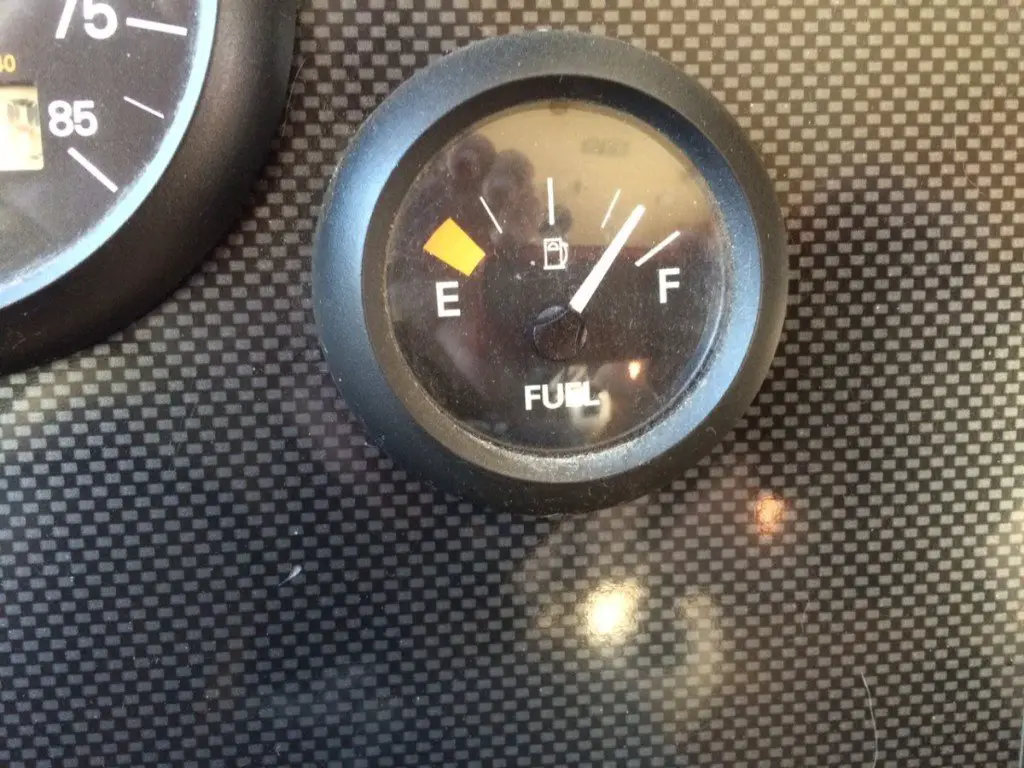
Power
- We ran our generator for 36.75 hours over seven days, which averages out to 5.25 hours at day.
- We’re still completing our calculation of how much fuel we consumed, but we think it was about a quarter of a tank, or 25 gallons. That’s 3.6 gal/day.
- Since we filled up with diesel at $2.25 prior to arriving at the Balloon Fiesta, that puts our daily power cost at $8.10/day.
That figure brings home the cost savings potential of dry camping. Of course, we were paying $24/night to camp at Balloon Fiesta, so we didn’t experience any cost savings there!
If we did indeed use 25 gallons of diesel total, that puts our consumption at 0.7 gal/hour. Keep in mind that we weren’t running our AC at all (we did run heat for maybe two hours total in the early mornings) and we didn’t run the washer or dryer. At the same time, we didn’t unplug unused devices. If we had, we may have been able to drop our diesel consumption slightly.
Water
We came out of the week with 1/3 tank of fresh water left (approx. 30 gallons), and we didn’t fill the black or gray water tanks. We know from experience that we can go two weeks with our black water tank. We don’t know for sure how long we can go with our gray water tank, but with our level of water usage during Balloon Fiesta, I’m confident we could make it two weeks. That said, I’d prefer a more generous water allowance!
Bottom line: Our limiting factor is our fresh water tank. Without making ourselves really uncomfortable, it would probably last us a week and a half.
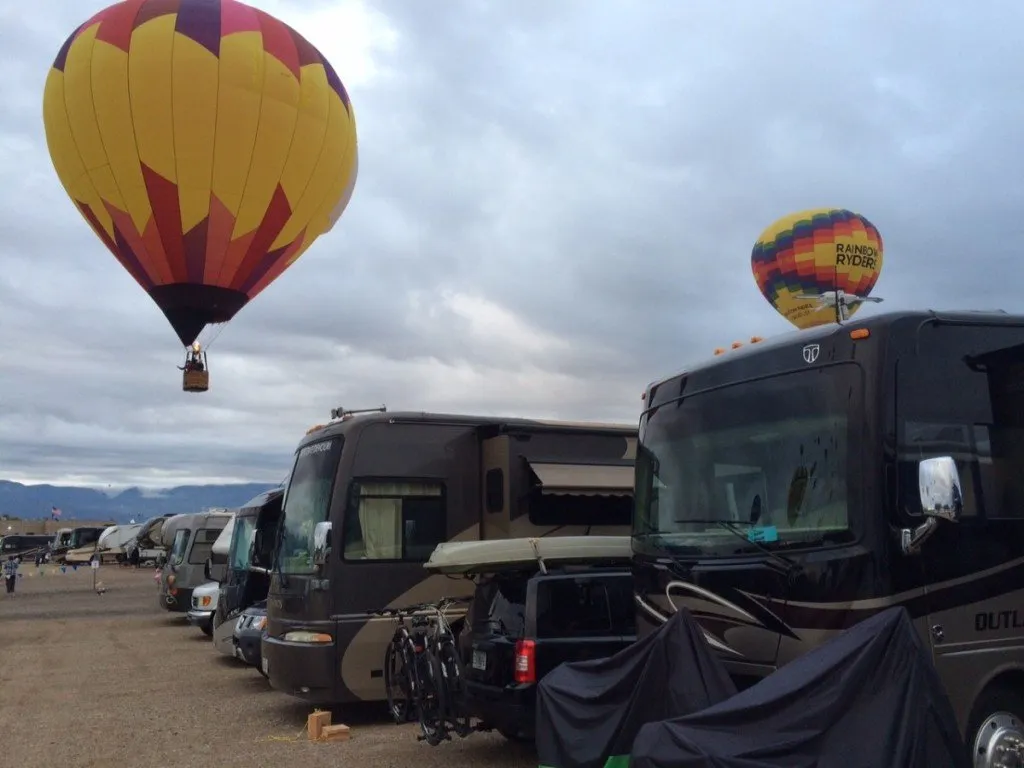
But Would We Do It Again?
Our first full week of dry camping was empowering. We had some idea of what we could do, but we had never done it. Now we have, and we will absolutely do it again! I’m most excited about the prospect of accessing beautiful and remote places we would never see if we insisted on full hookups.
I want you to know that you can do it, too! I encourage you to experiment and test your personal limits. Don’t feel like you have to be as wild as others if that isn’t your thing. But don’t miss out on amazing experiences due to ignorance. Equip yourself with knowledge about your rig and how it meshes with your individual habits and lifestyle. That way, you can keep your options open and jump on dry camping opportunities as they present themselves.
Why Haven’t You Mentioned Solar?
Solar opens up a whole other slate of possibilities when it comes to dry camping. Eric and I are considering a small setup we can build on. But I’m sure we won’t invest in an extensive system until we prove to ourselves that we’re going to dry camp regularly. Until then, it’s just not worth it.
But didn’t I mention that we’re not mechanically-inclined? You’re better off learning from those who have a lot more experience in this area than we do! Check out advice and tutorials from our friends:
- Gone With The Wynns: “Solar Power”
- Tales From the Mutiny: “How Solar Revitilized Our Fulltime Lifestyle”
- Technomadia: “Solar Electrical Systems for RVs”
Please comment if you have an article about RV solar to share (no spam).
-B

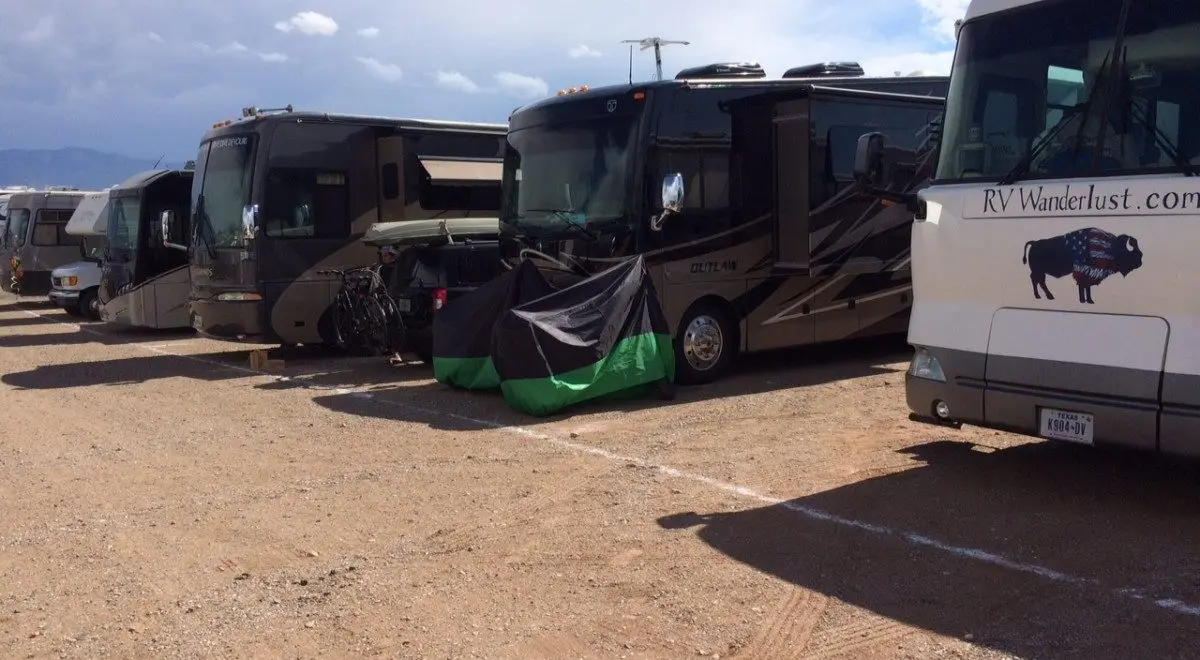




Ha ha, no matter how you slice it…if you are on the fence about Wild Camping (we like this term better than boondocking because it sounds neat) you will never know if its worth it or not for you, until you try it! So glad you guys made it through and are feeling like champs! Now we just need to get you that solar set up! Group install while wild camping?
If by “group install,” you mean you guys will set it up while we watch and cheer you on, then I think it could work out really well! In all seriousness, I know you guys have the “wild camping” thing down, and it’s definitely an inspiration to see all the amazing places you’ve had a chance to experience lately!
Can we get in on that group install? Ted can help, Sarah can join the cheerleaders!
Nice summary! We have similar feelings… we love the convenience of full hookups and campgrounds so it’s taken us a while to get comfortable stretching our wings a bit. We’re now pretty comfortable at electric-only sites in county/state parks, which gives us most of the convenience (air conditioning, heat pump, laptops) with most of the beauty. We’ve only dry camped twice (Big Bend National Park and Quartzsite) and our generator usage was similar to what you described. We’ve waffled about solar for over a year and finally just took the plunge (our 600W kit from AMSolar arrives on Monday)! We always felt that solar wasn’t going to be “worth it” because we dry camp so rarely, but then decided maybe we rarely dry camp because we don’t have solar. Hopefully the solar will help us branch out some more in 2016! -Mike & Kathie / LifeRebooted
Thanks for the comment, @disqus_sYn16Tsyng:disqus. Looking forward to an update from you in 2016 once you’ve had a chance to use your solar for a while. We’ve heard good things about AM.
Thank you so much for sharing! We haven’t dry camped either and we are a little wary. This made me feel so much better! ~Sarah
You can do it, Sarah! Looking forward to hearing your dry camping stories in the near future.
Hooray! Dry camping opens up so many other possibilities, and so glad you guys felt abundant during the convergence! But of course, not being comfortable with dry camping is nothing to feel limited by – as you’ve experienced, there’s never a shortage of amazing places to stay no matter your style. (We like variety personally.)
You actually can claim some savings however, even though we were paying for dry camping. For comparison to the $30/night for dry camping in the Standard Balloon Fiesta Lot, the electric/water sites were $65/night.
We’re incredibly fortunate to be able to create so much variety in our lives through the many places we “live.” And point taken with the cost comparison! I guess we did save quite a bit, after all.
Congratz! It sounds like you had a great experience. Dry Camping can open a lot of doors for you to experience new and exciting things or at least bring them closer to home. Free sites even with generator usage like you saw make dry camping a very economical option, and you really don’t have to give up much.
I did want to say, I am not sure what kind of usage you were having but it seems like you had to use the generator more often than what might be normal. Depending on your battery storage capacity, some battery maintenance might be a good idea.
@jeep_gypsies:disqus, thank you for the insight! We have a bearded dragon who needs to have a light on 24/7 in order to digest his food/live. The daytime bulb with UVA and UVB is large and pulls a lot of power.
Congratulations on bustin’ that boondocking cherry. ;-) If you enjoy it,
keep it up. Just learn how to go longer than a week on 90 gallons of
water!!!
Thanks!
RV Solar Power Expectations and Considerations
Hey guys! Will from Outside Found here. We do a lot of dry camping, all made possible with our solar setup detailed here: https://outsidefound.com/2015/08/reader-questions-living-with-go-power-solar/. We basically have the same setup as the Wynns with a little more battery capacity to get us through some of the shady days.
This setup has turned out to be the absolute best decision we made while working on our bus conversion. At one point over the summer we went more than four weeks without plugging into electricity, all the while running our laptops, monitors, and lights daily. The installation was really easy too with the help of an electrician!
Great article and congrats on your survival in the wild! :) We LOVE boondocking and do it as much as possible. It really does open so many more opportunities. Like driveway camping for free like we’re doing now in sunny Colorado! We do have a solar setup on our trailer which Roger has documented on our blog over here: https://rollingwithgrass.com/solar-setup/
Nice post Brittany. You guys did well with the water conservation. I’m surprised at the amount of fuel you used – are you calculating based on the fuel gauge alone or did you fill up to see the actual amount? I wouldn’t trust an analog fuel gauge to give an accurate reading. I’m pretty sure you have an Onan 7.5kW quiet diesel generator. Without running A/C your fuel consumption sounds high.
Hi @michaelkuper:disqus! As I mentioned in the article, we haven’t completed our calculation of how much fuel we consumed. Since we haven’t fueled up since then, I haven’t had a chance to subtract our mileage and find out how much diesel the generator really used. I’ll update the article when I know more!
excellent blog entry: I boondock frequently when on a cross country expedition, Here are a couple things I do to increase the water and electric capabilities.
1. For showers and washing dishes: I run the cold water that would normally go to the waste tanks while getting hot water “into a bucket”. I use that to flush the toilet clean after use.
2. I have an extra generator, a Honda 2000 watt and carry a five gallon container of gasoline with me, this generator works great, is quiet, and will run approximately 10 hours on a gallon of gasoline while in the economy mode.
3. Park in the shade when possible, on hot days. If shade isn’t available, I park my rig with the long axis parallel with the movement of the sun, thus, reducing the amount of exterior surface exposed to direct sun light. This really made a huge difference. Of course do just the opposite when boondocking in a cooler climate.
4. I carry gallon jugs of fresh water for drinking and cooking.
@disqus_PohcrwSS4d:disqus, you are clearly an experienced boondocker! Thank you for the pro tips.
You did it! Great post detailing the ins and outs of wild camping. We’ve been on the road for a few months now and have dry camped occasionally. Because we needed to be in a couple places by certain dates, we haven’t yet had the chance to truly Wild Camp, but are hoping to before winter settles in. We started with a great solar set-up already (which we had added on at NeXus (our manufacturer) because we, like y’all, aren’t so mechanically inclined) and it’s made a huge difference for us in our tiny Class B+. Thanks for sharing your experience!
Brittany,
Thanks for the great article. You ability to explain things clearly makes readying your articles so clear and concise. Always look forward to your posts. FYI. we have a 10K onan Diesel and we are seeing consistent 1/4 a gallon of usage an hour. BUT I believe our coach is a little newer than yours. When we had the Phaeton almost the same as yours it did use a little bit more (But not a lot). Also if you turn on AC, or other items it def affects the diesel usage. – Thanks for all you do. BTW, mentioned to Eric on FB> All of your Location Area updates and well as all of your Park Reviews are now up on http://www.mhrig.com and I will continue to keep them updated so we can learn from you when we are in the area!! – Keith L. .
Hey @keithlanders:disqus! Wow…1/4 gal/hour?? I wonder if my calculations were really off that much, or whether our generator is just that old. :) We should be filling up with diesel within the next couple of weeks, so I’ll recalulate then.
[…] https://rvwanderlust.com/rv-dry-camping […]
Congrats on your first dry camping excursion! This will open up a new world of camping opportunities and in the long run, you might even save some money. When reflecting on our favorite campsites, we’ve pretty universally found them to be dry.
Here’s some food for thought: on our recent Alaska adventure, from about the middle of June to about the end of September when we left Whitehorse to when we returned, we stayed in a site with power a grand total of two nights. The other 90 or so were dry. In many places there were full-service RV parks in town and we chose to dry camp, but often there were no other options.
Can I suggest two projects to assist you in your future boondocking and possibly help prepare you for a potential solar installation?
First, check into changing out your lights for LED’s, if you haven’t already. In many cases, it’s a simple matter of changing out the light bulbs or ( for florescent lights ) doing a little simple rewiring. Your energy savings for lighting could be 80% or more.
Second, ( and this might be a good project for Iron Horse RV ), have them install a battery monitor system. This will give you a much better understanding of how much power you have remaining in your batteries ( as % ) and tell you exactly how fast you’re draining/charging.
Armed with that information, you can better understand when to start the generator and how much to run it. It will also help you figure out which things in the RV are the power hogs and then make decisions about when/if to use them.
I suspect that you could well get by with half or a third of the generator use that you did at the Balloon Fiesta, so the payback period could be as little as 60 days of dry camping, by saving $5 a day on diesel, along with not having to do at least one oil change in that period ( every 150 hours, and about $120 if the dealer does it, right?)
Additionally, if you decide in the future to add solar, the first question that will need to be answered is: how much power to you use daily? And you’ll know the answer or at least have the tools to get it.
Finally, portable suitcase solar kits are fairly inexpensive, don’t require any installation and thanks to the tilt and the ability to move, often make more power on a daily basis than an equivalent roof top installation. If you get a roof top installation you can still use your portable ( they come in handy when camping in shady areas ) and if it turns out not to be your thing you can always sell it to recoup some of what you spent. It might be a good way to get your feet wet.
Welcome to the dry camping club. Happy camping and we hope to see you guys out in the boonies this winter!
@eric_udell:disqus, first of all, thank you for your time on this! Second, your insight reinforces some of the things we’ve been thinking about. So thanks for that, too!
LED lighting is definitely part of our long-term plan. Now we just have to save up the $2K, or whatever it’s going to be! We’re actually having Iron Horse install our first LED fixture next month (the whole fixture is bad, and we couldn’t get the old fixture even if we wanted to). So I guess that’s our first tiny step toward LED.
Battery monitoring systems were just brought to our attention at Balloon Fiesta, during a solar discussion that Chris and Cherie facilitated. We’re waiting on a quote from Iron Horse and may get one installed next month.
We also were taking a look at Roaming Pint’s portable suitcase kit at the fiesta. At least one other couple had one there, as well. From what we’ve heard and learned so far, you’re right to say that would be a good place for us to start.
Your insight may be the extra push we need to jump on these action items! It’s a brave, new world.
What a great article, thank you so much for sharing. We are in the process of seeing what we can and cannot do with our RV so this helps give me even more ideas and things to test so thank you!
We purchased a 5th wheel this month but will not be hitting the road full-time until mid April, so I have time to do lots of testing. Dry camping is something I am very interested in. So I am testing load limits on the generator and will be testing tanks/usage in the next coming weeks. Thanks for sharing your experience.
We are officially Texans, Normangee will be home base. Maybe we will meet at a convergence or on the road or even dry camp together in some remote beautiful location! Safe travels and enjoy home.
David & Lisa
Wow, pat yourself on the back for truly roughing it with only 5.25 hrs generator use per day. It is people like you who piss off the rest of us trying to enjoy dry camping without all of the noise, especially at 6:30 AM. Peace and quiet away from all your BS is WHY we dry camp. If you need that damn much electricity, stop fooling yourself, you are not hardcore, go to a KOA and stop ruining the outdoors for the rest of us please.
Hi @disqus_paaBMqf7Xi:disqus, thank you for reading our blog. I hope to be a good neighbor to you should we ever meet in person. I’m sure we could learn from your own personal RV challenges and misadventures. Be well and happy trails.
This a great article! We dry camp too, but currently @ a campsite. Thinking about heading back out to dry camp (which is why I found this article).
A diesel generator? Are you kidding? That is not dry camping. It is not even camping. I am 65 and camp alone in my tent comfortably with no hookups. Unfortunately, at my age, I can not do primitive camping or I would. I resent deeply not being able to camp without the noise of generators and the hum of air conditioners coming from RVs. You look young. You should give tent camping a try, too.
Hi @kellapitter:disqus. One of the things we love about RVing is that everyone can do it a little differently, to meet their needs. We are young, and very blessed to be starting our fifth year of full-time life (this article was written in our second year, which feels like forever ago). We still work full-time, Monday through Friday. Since we don’t have solar, we have to run our generator periodically, if just to charge our laptops and phones, so we can continue working for our clients. I also dislike the sound of the generator, and am always pushing to turn off the generator as soon as possible.